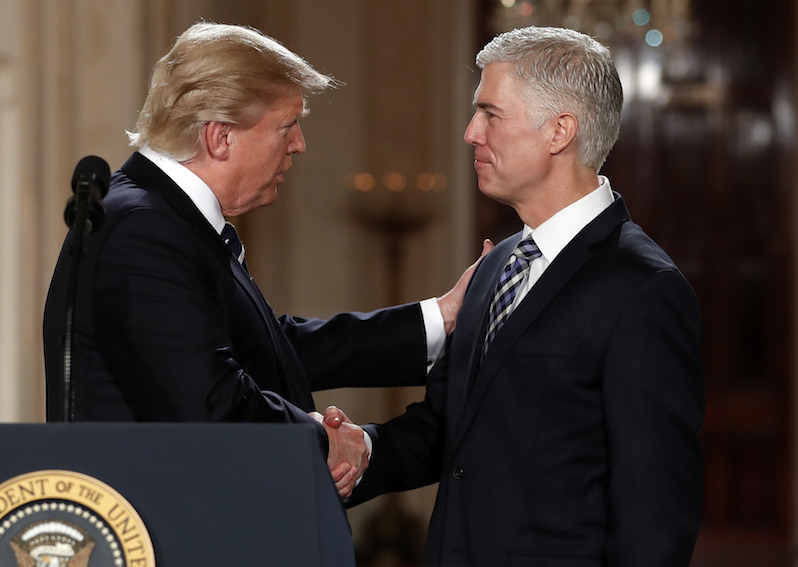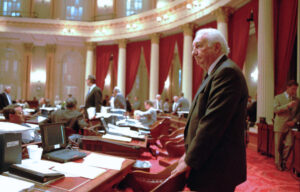Will Neil Gorsuch Flip on Trump?
Most likely, both the president's fears and the hopes of liberals about the newest Supreme Court justice are overblown. President Trump, left, shakes hands with Neil Gorsuch.(Carolyn Kaster / AP)
President Trump, left, shakes hands with Neil Gorsuch.(Carolyn Kaster / AP)
On April 7, 2017, after the Senate voted to confirm Neil Gorsuch’s nomination to the Supreme Court, President Trump was nothing short of ebullient. In a prepared statement, Trump praised Gorsuch’s “judicial temperament, exceptional intellect and unparalleled integrity,” calling him “the perfect choice” to replace Antonin Scalia, the conservative firebrand who had died in February 2016.
At the time, Gorsuch’s appointment was widely seen as the first step in Trump’s campaign not only to remake the Supreme Court, but to push the entire federal bench hard to the right. Now, however, the president is incensed that Gorsuch is too liberal and not a reliable conservative, according to The Washington Post.
What accounts for Trump’s buyer’s remorse is Gorsuch’s vote last week in a case concerning the deportation of immigrants who have been convicted of a “crime of violence,” as set forth in a provision of the Immigration and Nationality Act. In the case—Sessions v. Dimaya—Gorsuch deserted his conservative counterparts on the Supreme Court to join with the panel’s liberals in a 5-4 ruling that struck down the provision as unconstitutionally vague.
Although the practical impact of the case remains to be seen, it represents a significant setback to the administration’s deportation policies. But does Gorsuch’s vote in the case also signal that he has changed his political stripes, or more critically, that Trump’s plan to stack the Supreme Court and the lower federal courts with right-wing ideologues is in jeopardy?
I think not. Both Trump’s fears and liberal hopes in this regard are overblown.
First and foremost, a single opinion does not a judicial tenure make. Prior to casting his ballot in Dimaya, Gorsuch had established himself as a fixture on the high tribunal’s regressive troika, along with Justices Samuel Alito and Clarence Thomas.
As reported by the Scotusblog.com website, in his first three months on the court—from April to June 2017—Gorsuch voted in agreement with Thomas, long considered the most extreme outlier on the court, in every case that Gorsuch reviewed on the merits. He voted in line with Alito in 94 percent of his cases. On the other hand, he agreed with Justice Sonia Sotomayor, regarded by many as the most liberal associate, at a 58.8 percent clip.
As I have noted before in this column, the raw voting data told only part of the story of Gorsuch’s first term on the court. His votes in particularly contentious cases, combined with his written orders and opinions, were even more revealing.
In Trinity Lutheran Church v. Comer—an appeal from Missouri dealing with the “free exercise” clause of the First Amendment as applied to a church that had requested state funding to resurface the playground of a day care center—Gorsuch filed a concurring opinion that indicated he would be a staunch defender of “religious liberty.”
The majority opinion in the case, authored by Chief Justice John Roberts, held that Missouri had violated the church’s free-exercise rights when it denied the funding application. Roberts took great care, however, to limit his holding to the use of public funds for a “secular purpose.”
In his concurrence, joined by Thomas, Gorsuch expressed “worry” that Roberts’ analysis was too restrictive, admonishing his colleagues that the Supreme Court must be guided by “general principles” that “do not permit discrimination against religious exercise—whether on the playground or anywhere else.” By contrast, Sotomayor, writing for herself and Justice Ruth Bader Ginsburg, lamented that the decision weakened the “country’s longstanding commitment to a separation of church and state.”
Gorsuch’s right-wing outlook also was evident in the court’s controversial per curiam (unsigned) ruling on the Trump administration’s second anti-Muslim travel ban, issued last June. The ruling temporarily permitted part of the ban to take effect. Gorsuch, Alito and Thomas voted to reinstate the ban in its entirety.
Gorsuch similarly left his calling card in his first term in the fields of gun rights and campaign finance law. In the latter, he dissented from the court’s refusal to review a 9th Circuit decision that upheld California’s restrictions on concealed weapons permits. On campaign finance, he joined Thomas to dissent from the court’s decision not to take up a challenge to one of the last prohibitions that still exists in federal election laws post-Citizens United, which bars corporations from making contributions from their general treasury funds directly to political parties.
Although there are no gun-rights cases on the court’s docket this term, the third version of the president’s travel ban is back, and it will be argued this week. The issue of “religious liberty” is also on the docket this term in a Colorado case involving a Christian baker who refuses to decorate and sell wedding cakes to gay and lesbian couples (Masterpiece Cakeshop Ltd. v. Colorado Civil Rights Commission).
In addition, the current term includes as yet undecided high-profile cases on political gerrymandering, redistricting, voting-roll purges, public-employee unions, class actions and abortion. Many observers anticipate 5-4 splits in such cases, with Gorsuch toeing the conservative line. Gorsuch did just that in a major immigration case (Jennings v. Rodriguez) decided in February by a 5-3 margin (Justice Elena Kagan had recused herself), in which the court ruled that detained immigrants awaiting deportation have no statutory right to periodic bail-review hearings.
None of this detracts from the independence Gorsuch displayed by breaking from the conservative ranks in the Dimaya case. Still, it’s vital not to get carried away by such a small sampling.
Gorsuch’s concurrence in Dimaya was entirely consistent with the reputation he earned during his career on the 10th Circuit as a Scalia-like “originalist” in the interpretation of constitutional law. The problem with the immigration act’s use of the term “crime of violence,” he reasoned, is that it was so vague, people and judges are forced to guess what it means. Both Gorsuch’s concurrence and the majority opinion, written by Kagan, were based on Johnson v. United States, a 2015 ruling in which the court, in an opinion by Scalia, struck down a similarly vague provision contained in the Armed Career Criminal Act.
“Vague laws,” Gorsuch began his concurrence, channeling his inner Scalia, “invite arbitrary power. Before the Revolution, the crime of treason in English law was so capaciously construed that the mere expression of disfavored opinions could invite transportation [exile] or death.” Gorsuch also hastened to add, perhaps to assuage those who might see him as a political turncoat, that the deportation statutes still apply to immigrants convicted of murder, rape and other crimes, such as the sexual abuse of minors—which are clearly specified in the immigration act as deportable offenses.
If Gorsuch sticks to his originalist principles, he could well join the liberals in another important case—Carpenter v. United States—the court will resolve by the end of the present term on whether the Fourth Amendment requires law enforcement to obtain a warrant before seizing the historical cellphone records of criminal suspects.
Like Scalia, Gorsuch may occasionally go rogue in a few significant but essentially niche areas. That’s a good thing, both for liberals, and for the court as an institution. In general, however, Gorsuch will in all likelihood prove to be every bit as conservative as Scalia.
Trump’s histrionics aside, Gorsuch won’t upset the president’s plans for reconstituting either the Supreme Court or the rest of the federal judiciary. Trump is getting his advice on judicial appointments from both The Federalist Society and The Heritage Foundation, and thus far, he has closely followed their suggestions.
According to Mother Jones magazine, during his first year in office, Trump handed out 69 judicial nominations. Of these nominees, 92 percent were white, 71 percent were male and 55 percent had Federalist Society affiliations. He has added to those totals since then, and will now get to name a replacement for Stephen Reinhardt, the 9th Circuit’s liberal stalwart, who died March 29.
The Supreme Court, of course, remains the grand prize. With the aging of the court—Ruth Bader Ginsburg is 85, Anthony Kennedy is 81 and Stephen Breyer is 79—Trump will probably get to make at least one more appointment to the nation’s most powerful judicial body this term or—perish the thought—next term, if he is re-elected.
When and if that happens, Gorsuch’s maverick concurrence in Dimaya will be long forgotten.
Your support is crucial…With an uncertain future and a new administration casting doubt on press freedoms, the danger is clear: The truth is at risk.
Now is the time to give. Your tax-deductible support allows us to dig deeper, delivering fearless investigative reporting and analysis that exposes what’s really happening — without compromise.
Stand with our courageous journalists. Donate today to protect a free press, uphold democracy and unearth untold stories.









You need to be a supporter to comment.
There are currently no responses to this article.
Be the first to respond.